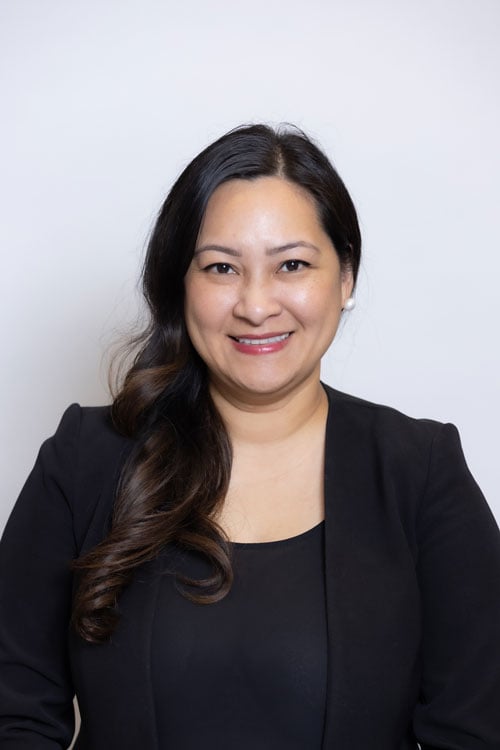Commissioners’ Corner: Leaders' Essential Role in DEIB
4 min

Lourdes Moldre, MSN, BSN, RN, ACNP-BC, is a nurse executive patient care director at University of California San Francisco (UCSF) Health Parnassus and Mount Zion Hospitals, where she oversees operations involving more than 800 staff members. She has over 20 years of healthcare experience as a front-line RN, an acute care nurse practitioner, and as a nurse leader. President-elect of the Philippine Nurses Association of Northern California (PNANC), she serves as an adviser for two other PNANC chapters. In 2022, she was recognized as a 40 under 40 honoree by the San Francisco Business Times, given to up-and-coming young leaders across the Bay Area. In 2023 she was a delegate in the Filipino Young Leaders Program sponsored by the Philippine Consulate, U.S. Embassy and Ayala Foundation to strengthen the U.S. and Philippines relationship.
How does a leader advance or hinder DEIB and antiracism?
Leaders can advance DEIB and antiracism by including DEIB initiatives as part of their strategic plans. If a leader sponsors DEIB activities, then those initiatives will advance. Basically, they vet DEIB interventions and follow them with metrics. Leadership is very crucial in having key stakeholders engage with those strategic plans and initiatives. Conversely, leaders hinder these efforts when they’re not aware or don’t believe that racism is happening. Some leaders may appear to be closed off in even understanding racism. I'm very lucky here at UCSF because we have diverse women of color executive leaders who are my own mentors and sponsors. I'm very thoughtful about those relationships in leveraging DEIB programs and other opportunities to advance belonging in our organization.
What are the most impactful things that a leader can do to create a culture of DEIB?
On top of sponsoring DEIB friendly activities, role modeling for other executive leaders, and carving out time to mentor and sponsor future leaders in the pipeline. The fireside chat webinars our organization hosts internally shows new leaders of color that it’s possible. At UCSF, our Leadership Institute in partnership between our School of Nursing and Health System involves a very solid training program, with both theory and mentorship for new leaders. DEIB is an important component of this.
What can an individual leader, an organization, and the nursing profession overall do to enable more nurses of color to become leaders?
Enrolling them in comprehensive programs like UCSF’s Leadership Institute. Providing nurses of color time for mentorship and sponsorship. Telling them it’s possible to successfully lead and for their voices to be heard. Ongoing motivation matters, and it’s something I do myself. I have mentees of various races in and outside of nursing because I want to develop the pipeline of leaders from the beginning. Some are nursing students and even new graduate nurses. Having the intention and carving out 10%-15% of executive leaders’ time, creating spaces and forums for nurses of color to thrive, be heard and seen. Creating a psychological space to speak up. A commonality among nurses of color in leadership the challenge of finding their voices. Providing constructive tools to help them authentically and confidently express themselves is vital.
People often say that the frontline nurse manager is the hardest role in nursing. How do the dynamics of DEIB and racist attitudes complicate or enhance their work?
Nurse managers have one of the hardest leadership role transitions from being frontline staff nurses into management. Additionally, because they're so close to day-to-day operations and the passion of providing best quality patient care, it’s extra challenging for them to see objective decision-making information. The UCSF Leadership Institute offers DEIB tools that frontline nurse managers can use and benefit from. We also support nurse managers in hiring nurses, with a DEIB toolkit called “We Belong.” Having very aware and skilled nurse managers engaged with DEIB initiatives is critical in advancing DEIB work. If it’s lacking it can hinder an organization.
What are the joys and challenges of being a nurse of color in leadership?
A joy last week was when an MRI nurse leader, a Filipino nurse of color, whom I’ve been mentoring but who doesn’t report to me, pushed through a project involving an MRI refresh. An issue was impeding operations, and this nurse leader stepped up and solved the problem. But initially he didn't know how to navigate this multidisciplinary project. In my mentoring, I explained to him ways to engage others and showed him strategic ways to present his idea. Working with him from start to finish was very gratifying, because he didn't know when the project started that he would be able to do what he eventually accomplished. He felt empowered and that his voice was heard throughout the process. It was truly fulfilling to celebrate this win with him!
What's hindering is that I want to mentor more emerging leaders, but don’t have a lot of time beyond the 15% I’m already carving out. So, I’ve been mentoring effective new leaders and hoping that they can mentor others, creating a well-oiled machine of mentorship. As I role model these vital mentorship practices to new pipelines of nurse leaders, I’m hoping that this culture will expand exponentially.
The Commission has outlined clearly how racism has and continues to affect nurses and the nursing profession. How have you experienced racism in nursing as a clinical nurse, nurse practitioner, and now a nurse leader?
I was 13 years old when I moved from the Philippines to California. As I immersed myself back then, I was just trying to balance my culture back in the Philippines and in the U.S. When I became a nurse and new graduate at UCSF, I was very focused on growing as a professional; however now looking back some racism was happening around me, but I wasn’t paying attention to it. I also connected with my peers and found rich stories from the past, especially the 1960s to 80s, even in San Francisco, where it would have already been diverse. Conversations took place where it was stated, “a Filipino nurse will never be in a leadership role.” In comparison to those remarks, my experience has been better, but it’s still happening because of implicit bias. I know there were roles I was passed up on because of my gender, and probably my color. Navigating those challenges has made me a better, stronger leader.
As a leader, I’m still experiencing these challenges. Once during a board meeting someone thought I was an assistant just because of my age. Because of this, I’m very thoughtful and aware of how I talk, how I show up every single day. I always make sure that I'm prepared because what if this is the only chance I have to represent myself? That's a commonality of women leaders of color, always putting in 110% because that may be our only chance to show we’re effective versus other counterparts who might have many opportunities to show their skills.
If you were hearing when you were in school or starting as a staff nurse things like “a Filipino nurse is not going to be in a leadership role,” how did this affect you since you’ve obviously become a leader?
I took it in and reflected on it. I thought that maybe because of my color I couldn’t advance myself. Plus, I didn’t see many Filipino nurse leaders as role models or mentors when I was a new nurse. At that time, there were many Filipino nurses, but not many who advanced beyond an RN degree. On the flipside, my parents always said the goal when we moved from the Philippines to the U.S. was for us to have better lives. I internalized that and got my master’s five years into my nursing role. Looking back, my parents taught me to have grit and ethics of working hard for my goals. I knew back then that I was going to break the barrier even if I didn’t know how I was going to do it.
What has been the most positive antiracist moment for you in nursing?
One of the most impactful conversations that I’ve had was with my mentor Sheila Antrum, now COO of UCSF, and a nurse leader of color. In a one-on-one meeting she told me if there was ever a time when I was trying to understand whether a conversation or interaction involved racism, to please reach out to her so that she could help me debrief. That was powerful because she understood where I was coming from. My supervisors at the time were Caucasian males, and it would have been hard for me to articulate those experiences with them. Having another leader, a woman nurse leader of color, offer their time to process these things was very meaningful to me. That's when I told myself, “Wow, I know I’m at the right place at the right time here at UCSF.” It made me realize that I want to do the same for others.
How do you deal with a person—whether staff nurse or another leader—who doesn't believe there's racism in nursing?
That's quite common. We encounter it daily both with staff nurses and current leaders. I think by offering understanding and empathy through intimate conversations and hearing their perspective, helping them articulate why they think that way. They're not aware because they're not experiencing it themselves. Versus as a person of color who’s experiencing all these things, we think about it all the time. Offering education, patience, and understanding that it's not that they don't care, they just don't know.
What’s the one thing that you would like White nurses to know about racism in nursing?
Just understanding the types of microaggressions still happening, such as, “Wow, you speak English well!” People might not realize when they say things like that it's a form of microaggression. And for nurses of color, we typically don’t speak up, because it's part of our culture to not question. But it's OK to respectfully speak up and educate others.
What would you most like White nurses to do about racism in nursing?
Partner with nurses of color. Uplift them. Ask, “What can I do to make you feel welcomed?” We want all nurses to have a sense of belonging, to celebrate them and their diverse and rich culture.
What would you most like to convey to nurses of color?
We already have impostor syndrome, being women leaders, and being nurses of color is even harder. I would tell them to lead with their heart, understanding their sense of purpose, and continue to use their voice. Being authentic and speaking up as much as possible—respectfully, of course—so other nurses of color can learn from them. Staying visible and continue representing is critical to show up for our communities.
What will it take for nursing to become truly diversified and inclusive for everyone?
It starts from the entry points—nursing schools. Figuring out the opportunities and resources for students experiencing these things, having holistic admission requirements, a diverse pedagogy of books, virtual simulations that represent all people of color. In hospital settings, equipping nurse managers with DEIB toolkits that guide them in looking not only at new grads’ GPAs but also volunteer opportunities and programs they’ve participated in. Providing psychological safety for existing staff members and celebrating diverse cultures. Having a resource, even from a third party, where team members can report when they experience racism and know there will be accountability by the relevant leaders. Using dashboards to show how well the organization is doing with its DEIB efforts. Partnering with the community for its ideas on diversifying the workforce.
What gives you hope and what discourages you about seeing change in the nursing profession?
I'm more hopeful and positive that we’ll see change because of leaders like me and my peers who are voicing the change that we want. Policymakers too are listening to us, as institutional and governmental policies need to change. I'm hoping that people won't lose their momentum, their inspiration, and their spark to create change. So many groups are still underrepresented, and they don't know how to navigate the system. The key is coming up with a very cohesive way to provide a voice for everyone to feel represented.
What future state of nursing do you envision?
I envision each nurse being able to celebrate their most diverse self without feeling scared that they’ll get in trouble. I want nurses from non-diverse backgrounds to be more aware of the challenges nurses of color are going through. Additionally, educating patients on examples of microaggressions that reflect racism. Also, having accountability for our metrics. Right now, it's all exciting because we're hyper-focused and aware plus there's momentum. But what about in 10 years, when it's not as exciting anymore? We’ll still need to push through and accomplish critical work. We need to carve out task forces that don’t just depend on volunteer time, but also include paid positions in healthcare, community, or governmental organizations.



